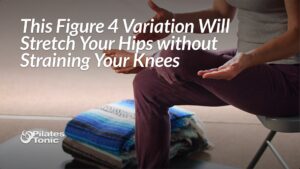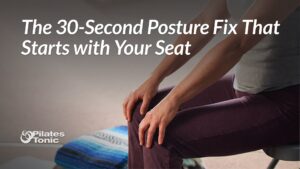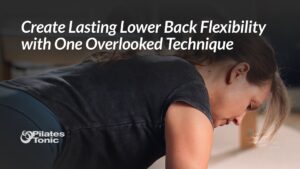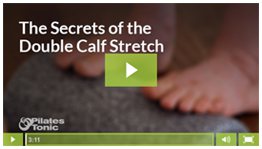Today’s video is going to show you exactly what key exercises you need to do for your ideal pelvis and spine alignment.
There are many finer points to this alignment, more than we can cover in this short, 4-video series, but what you learn today is the most critical and can make the difference between really great body movement and problems you really don't want.
Research has shown that when the pelvis is out of alignment, the core muscles don't always turn on automatically when they’re needed and this causes other muscles to activate instead. This throws your whole body out of whack (that’s a technical term 😉 ) and that’s what can lead to lots of unnecessary problems. It can also make your other exercise routines less effective, or even harmful.
Now, before we dive into the core of today’s video, you need to know that there are two super-critical muscle groups that we’ll be working with in the coming weeks' videos (your deep spine muscles and your deep abdominal support belt), but many people don’t get these important connections right because they skip the critical alignment that I’m going to show you today.
What I’m trying to say here is that today’s video is a big deal, so don’t skip it! 😀 Good alignment will make understanding and establishing core connections easier, more natural and automatic.
After today’s video you’ll know exactly how to find your ideal alignment. I recommend using a mirror when you're first getting used to what your ideal alignment feels like. That way you can feel and see your ideal alignment at the same time.
Retraining my own alignment patterns has been a long process that has taken some getting used to! But, luckily, my ideal alignment patterns now feel normal, at least most of the time. 🙂
This process may seem simple, but it holds some very powerful benefits for you that you can’t get any other way. If you have trouble with it, or if you have any “AHA!” moments, be sure and let me know in the comments below. I’d love to hear about it either way and I'm here to help if you have questions!
See you in the studio,
Sydney





9 Responses
Great video, I enjoyed it.
Thanks Belinda! I’m glad you enjoyed the video. It’s great to hear from you. Hope you are doing well!
Hi Sydney :), watched a few videos so far and loved them! I was wondering, why do you say that there are 3 bones that create the pelvis and that they are 2 iliums and a sacrum?
You call the ilium, ischium and pubis together the ilium? And why don’t you mention the coccyx as part of the pelvis?
Thanks :).
Hi Katia, it would’ve been better for me to say there are two pelvic halves that each contain three bones ilium, ischium (sit bones), pubis and that the sacrum is wedged between the two halves. The coccyx is at the end of the sacrum. For the purposes of this video I chose not to mention the coccyx as separate from the sacrum. Thanks for your questions!
Hi Sydney ~ learning so much from your work. Thank you! For sure, I am one who struggles with firing my core musculature due to faulty alighment. My question though, is about those of us with lateral shift alingment issues. To a great extent, I’ve had success improving my anterior pelvic tilt, and finding neutural pelvis in the sagital plane, but what can I do about this shift of my ribs to the right (and pelvis to the left) in the frontal plane? I’m still working with the handtowels in my “hollow” spots as you suggested 🙂 in supine..which help some… but seems I’m just stuck in this “shift”. Even my head tilt reflects it – causing jaw and neck issues…. and I KNOW it’s not allowing me to load the joints properly and get good push-off in gait. So much appreciate any guidance you may lend, or even referral to articles that may be helpful! Best ~
Hi Robyn, Something you could try, is lightly placing your hands, alongside your ribs while seated with your sitting bones and feet grounded and your sternum soft. Sense your spine in your body. If you have a shift to the right, then on an exhale see if you can connect your touch on the right side of your ribs through your body to your touch on the left side. You want the effort to connect your right side to the left to be a very internal movement generated by your exhale. Try to hold this connection for 5-10 breaths. This is a challenging one to explain through words alone, so let me know if this makes sense! Also, I think you’ll find the next two video blog posts very helpful! If you sign up for the mailing list you’ll be notified as soon as the videos are posted. Thanks for your question!
Wow, yes thank you for the wonderful imagery. You are just so excellent at teaching this very challenging work. I really wish you were closer to home and I could work with your personally. I will continue working on the rib shifting in an “internal” way as you have described. I know I sometimes overcorrect and “shove” my torso left trying to get aligned, and I know these movements need to be on a “micro” level. I have signed up to be on your mailing list (a few times perhaps) … do not want to miss any of your posts as I am truly feeling like you speak my language in many regards. I’m not a professional, but have self-studied for a few decades trying to overcome chronic pain and avoid more surgeries. Let me know if you ever work with folks virtually on Skype etc. I would imagine it’s challenging not to be hands on 🙁 .. Do you ever travel to teach – I spend several months in Miami in winter, and I’m in NY (East end of Long Island) the rest of time.
wondering, would it be appropriate to imagine the hand/fingers on right ribs being pulled (just slightly) by a magnet on the left side? Also thinking it’s probably key to keep the pelvis anchored down using pressure from the sitting bones so as not to take the pelvis with me to the left (which what I tend to do). Very excited and looking forward to the upcoming posts you mentioned earlier too! 🙂 Thanks again.
I love the image of a magnet on the left side gently bringing the right side of your ribs into your body. That’s great! And yes to keeping your pelvis stable so that it doesn’t move with your ribs. 🙂 I don’t currently travel to teach, but I do offer Skype sessions. You can email info@pilatestonic.com for more information and/or to schedule a session. Thank you!